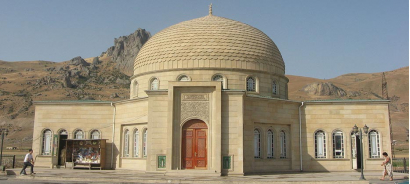Pir Khidr Zinda or Legend About Besh Barmag

Pir Khidr Zinda - or Khidir Zunja - is a sacred place for Muslims, located at the foot of the Beshbarmag Mountain in the district of Siyazan, Azerbaijan.
Abbasgulu Agha Bakikhanov, an Azerbaijani writer, historian, journalist, linguist, poet and philosopher, acknowledged in his famous book “Gulistani-Irem”, which is one of the most important sources of our history, that the Majma-ul-Bahrain, i.e. the confluence of the two seas, mentioned in the Quran was alleged to be located in the Shirvan province. The domes of the rock of prophets Musa and Khidir are also located there. Expressing his views on this, Bakikhanov points to related scientific considerations by other authors.
The word ‘zinda’ means ‘alive' or ‘immortal', which is a sign of Prophet Khiḍr who is found to be immortal to be linked with some of the most ancient legends known to us today, because he drank from the water of life. Therefore, the people used to call Beshbarmag Mountain, five naked peaks, 'Khidr-Zinda Baba' or 'Khidrzinda Mount' located in the Siyazan district on the coast of the Caspian Sea. Various legends of Beshbarmag live on: Ramzi Yuzbashov, a researcher, manifests that the word 'barmag' in 'Beshbarmag' means a 'shish hill.' According a another theory, Beshbarmak denotes a 'finger'. So, in the etymology of the people, a 'big toe' means an elder brother.
In the map of the Caspian Sea created in 1375 in the Spanish province of Catalonia, Beshbarmak is known as Barmag, while as “Marmakh” on the map of Adam Oleari, a duke in the feudal county of Holstein in the 17th century. The second volume of the Encyclopedia of Azerbaijan is written as follows: "Beshbarmag was a defense gate belonging to the IV-VII centuries. This barrier lies from the skirts of Beshbarmag to the Caspian Sea. At the foot of the mountain, the large barbed bricks were composed of two walls with two hundred meters apart. Albanian historian Movses Kalankatli noted that the Beshbarmag barrier was built under Sasani King Yazdegir (437-457). It was built to prevent the attack of normadic people... "
So, Khidr-Zinda is a sacred place, as well as one of the indescribable heritage of our glorious history.
Aydin Tagiyev
AND OTHER...
-
 Khagani Shirvani’s Creativity on the Literary Portal of England
Khagani Shirvani’s Creativity on the Literary Portal of England
“Write Out Loud”, the leading poetry portal of England, has posted in English the ghazal “A Love Song” by the great Azerbaijani poet Khagani Shirvani as part of the...
-
 Isi Malikzade’s Creativity on German Literature Magazine
Isi Malikzade’s Creativity on German Literature Magazine
LESERING.de, a popular German e-literature magazine, has posted in German the short story Salt by Isi Malikzade, the notable Azerbaijani writer, as part of the AzSTC project “Azerbaijan Literature in an International Virtual World”.
-
 Movlud Movlud’s Short Story on Turkish Portals
Movlud Movlud’s Short Story on Turkish Portals
“Detayhaberler.com”, “Dibace.net” and “Haber.232.com”, leading Turkish portals, have posted in Turkish the short story “We Have Already Grown Up” by the...









